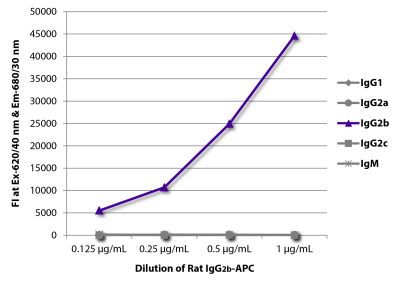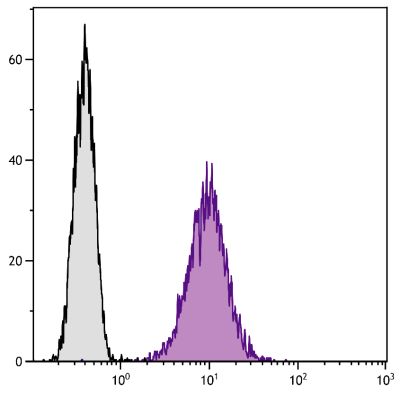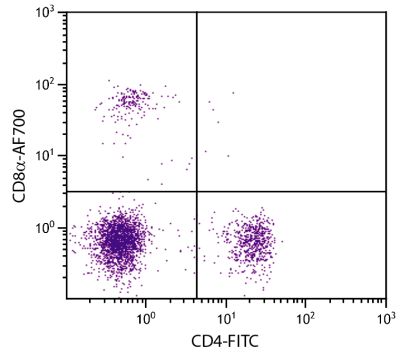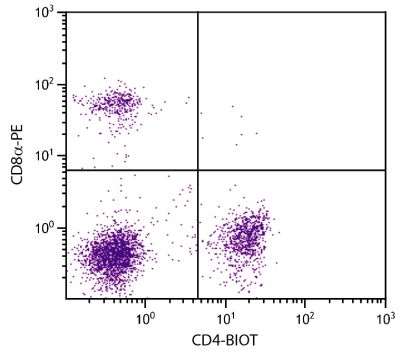Rat Anti-Mouse CD86-APC (2D10)
Cat. No.:
1915-11
APC Anti-Mouse CD86 antibody for use in flow cytometry assays.
$272.00
| Clone | 2D10 |
|---|---|
| Isotype | Rat (Lewis) IgG2bκ |
| Isotype Control | Rat IgG2b-APC (KLH/G2b-1-2) |
| Specificity | Mouse CD86 |
| Alternative Names | B7-2, B70, Ly-58 |
| Description | CD86 (B7-2) is an 80 kDa type I integral membrane protein and a member of the immunoglobulin superfamily of cell surface receptors. Along with CD80 (B7-1), CD86 participates in T cell costimulation via interaction with CD28 and CD152 (CTLA-4). It is expressed at very low density in normal tissues but is rapidly upregulated on stimulated B cells, monocytes, and dendritic cells. Since CD86 has rapid kinetics of induction, it is believed to be the major CD28 ligand expressed early in the immune response. |
| Immunogen | Mouse B cell lymphoma cell line 5C2 |
| Conjugate | APC (Allophycocyanin) |
| Buffer Formulation | Phosphate buffered saline containing < 0.1% sodium azide and a stabilizer |
| Clonality | Monoclonal |
| Concentration | 0.1 mg/mL |
| Volume | 1.0 mL |
| Recommended Storage | 2-8°C; Avoid exposure to light; Do not freeze |
| Applications |
Flow Cytometry – Quality tested 1,2,4,6,7 Immunohistochemistry-Frozen Sections – Reported in literature 4 Immunoprecipitation – Reported in literature 1 Blocking – Reported in literature 1-3,5 Separation – Reported in literature 2 Complement Mediated Cell Depletion – Reported in literature 2 ELISA – Reported in literature 3 |
| RRID Number | AB_2795518 |
| Gene ID |
12524 (Mouse) |
| Gene ID Symbol |
Cd86 (Mouse) |
| Gene ID Aliases | B7; B7-2; B7.2; B70; CLS1; Cd28l2; ETC-1; Ly-58; Ly58; MB7; MB7-2; TS/A-2 |
| UniProt ID |
P42082 (Mouse |
| UniProt Name |
CD86_MOUSE (Mouse) |
Documentation
Certificate of Analysis Lookup
Enter the Catalog Number and Lot Number for the Certificate of Analysis you wish to view
- 1. Chen C, Faherty DA, Gault A, Connaughton SE, Powers GD, Godfrey DI, et al. Monoclonal antibody 2D10 recognizes a novel T cell costimulatory molecule on activated murine B lymphocytes. J Immunol. 1994;152:2105-14. (Immunogen, FC, IP, Block)
- 2. Roth R, Nakamura T, Mamula MJ. B7 costimulation and autoantigen specificity enable B cells to activate autoreactive T cells. J Immunol. 1996;157:2924-31. (FC, Sep, CMDC, Block)
- 3. Bagenstose LM, Class R, Salgame P, Monestier M. B7-1 and B7-2 co-stimulatory molecules are required for mercury-induced autoimmunity. Clin Exp Immunol. 2002;127:12-19. (Block, ELISA)
- 4. Issazadeh S, Navikas V, Schaub M, Sayegh M, Khoury S. Kinetics of expression of costimulatory molecules and their ligands in murine relapsing experimental autoimmune encephalomyelitis in vivo. J Immunol. 1998;161:1104-12. (FC, IHC-FS)
- 5. Shanafelt M, Kang I, Barthold SW, Bockenstedt LK. Modulation of murine Lyme borreliosis by interruption of the B7/CD28 T-cell costimulatory pathway. Infect Immun. 1998;66:266-71. (Block)
- 6. Grodeland G, Mjaaland S, Roux KH, Fredriksen AB, Bogen B. DNA vaccine that targets hemagglutinin to MHC class II molecules rapidly induces antibody-mediated protection against influenza. J Immunol. 2013;191:3221-31. (FC)
- 7. Matsuo H, Yoshimoto N, Iijima M, Niimi T, Jung J, Jeong S, et al. Engineered hepatitis B virus surface antigen L protein particles for in vivo active targeting of splenic dendritic cells. Int J Nanomedicine. 2012;7:3341-50. (FC)
See All References






